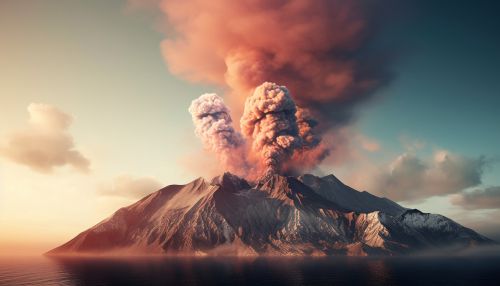Volcanic gases
Introduction
Volcanic gases are a group of volcanological phenomena that include the emission of gases from volcanoes during eruptions and quieter periods. These gases are primarily water vapor, carbon dioxide, and sulfur dioxide, but can also include a variety of other compounds depending on the specific nature of the volcano and eruption.


Composition
The composition of volcanic gases is highly variable, but water vapor is typically the most abundant component, followed by carbon dioxide and sulfur dioxide. Other common constituents include hydrogen sulfide, hydrogen, carbon monoxide, and a variety of trace gases and volatile metals. The exact composition can vary greatly depending on the type of magma from which the gases are derived, the depth at which the magma is stored, and the pressure and temperature conditions under which the gases are released.
Water Vapor
Water vapor is the most abundant volcanic gas, typically comprising more than 60% of total emissions. It is released from magma as it ascends and depressurizes, and can also be derived from surrounding rocks and the atmosphere.
Carbon Dioxide
Carbon dioxide is the second most abundant volcanic gas, typically comprising up to 40% of total emissions. It is a primary volatile component of magma and is released during both eruptions and quieter periods of volcanic activity.
Sulfur Dioxide
Sulfur dioxide is a common component of volcanic gases, typically comprising up to 10% of total emissions. It is released from magma as it ascends and depressurizes, and can also be derived from surrounding rocks.
Emission Mechanisms
Volcanic gases are emitted through a variety of mechanisms, including explosive eruptions, passive degassing, and ground diffusion.
Explosive Eruptions
During an explosive eruption, gases are released rapidly and violently as magma is ejected from the volcano. This can result in the formation of large plumes of gas and ash, which can rise high into the atmosphere and have significant impacts on climate and air quality.
Passive Degassing
Passive degassing occurs when gases are released from a volcano during periods of non-eruptive activity. This can occur through vents and fumaroles, or through diffuse emissions from the ground surface.
Ground Diffusion
Ground diffusion is a process by which gases are released from the ground around a volcano, often through cracks and fissures in the earth's surface. This can occur in the absence of any visible volcanic activity, and can be a significant source of volcanic gas emissions.
Impacts
Volcanic gases can have significant impacts on the environment, climate, and human health. These impacts can be local, such as the effects of volcanic smog on air quality, or global, such as the effects of large-scale eruptions on climate.
Environmental Impacts
The environmental impacts of volcanic gases can be significant. Sulfur dioxide and other sulfur compounds can contribute to the formation of acid rain, which can damage vegetation and aquatic ecosystems. Carbon dioxide and other greenhouse gases can contribute to global warming.
Climate Impacts
Large-scale volcanic eruptions can have significant impacts on the global climate. The injection of large amounts of sulfur dioxide into the stratosphere can lead to the formation of sulfuric acid aerosols, which can reflect sunlight and lead to cooling of the Earth's surface.
Health Impacts
Exposure to volcanic gases can have significant health impacts. Sulfur dioxide can cause respiratory problems, particularly in people with pre-existing respiratory conditions. Carbon dioxide can be a suffocation hazard in high concentrations, particularly in enclosed spaces.
Monitoring and Research
Monitoring of volcanic gases is an important part of volcano monitoring and research. It can provide valuable information about the state of a volcano and its potential for future activity.
Gas Monitoring Techniques
A variety of techniques are used to monitor volcanic gases, including ground-based sampling, remote sensing, and the use of unmanned aerial vehicles (UAVs).
Research Applications
Research on volcanic gases can provide valuable insights into a wide range of topics, including the composition and dynamics of the Earth's interior, the impacts of volcanic activity on the environment and climate, and the hazards posed by volcanic gases to human health and safety.
